The Faith, Art, and Theology of the Body blog of Shana Smith...and the Word became flesh... (John 1:14)

Sunday, December 30, 2012
Paint Study for St. Lucy Project
I painted this a few months ago, as part of the portfolio I was preparing for my application to the course in Sacred Art and Craft in Florence I am currently enrolled in. I consider it a "rough draft" for a more finished painting I hope to do sometime. This study gives me a better idea about how the colors (and other elements) I was thinking about work together as a whole.
The photo quality is pretty blurry, but seeing as how it's not a finished painting and is painted pretty crudely I suppose that's acceptable.
Any constructive feedback?
Saturday, December 1, 2012
Update from Florence
I have only a few minutes to write this but I need to post an update that I am currently in Florence, Italy and will be starting a course on Sacred Art and Craft in a few days. I came here about week ago to join the selection from which they chose who will be participating in the course, and from which they chose who will recieve a scholarship through the Florence Chamber of Commerce. I am happy to say that I did receive the scholarhsip (and am much relieved seeing as how I came over here not knowing for sure whether I would get it and be able to participate in the course). For more information on the program I am involved in, refer to this website.
http://sas-f.com/
(Google translate is always helpful if you don't read Italian).
Please pray for me that things continue to work about and also because the course is in Italian, which I have only been studying for a month-- but there are teachers that are native English speakers). My internet access is limited here but I will update as I am able.
http://sas-f.com/
(Google translate is always helpful if you don't read Italian).
Please pray for me that things continue to work about and also because the course is in Italian, which I have only been studying for a month-- but there are teachers that are native English speakers). My internet access is limited here but I will update as I am able.
Monday, October 8, 2012
Emily's Consecration Trailer and Some Reflections on Consecrated Virginity, Art and the Theology of the Body
I'd like to share this beautiful short video which captures the beauty of the day my friend, Emily, recieved the Rite of Consecration to a Life of Virginity. (Emily is the model for my St. Lucy project underway, which I have written about in a previous post).
Emily Byers Consecration Trailer from Infinite Focus Video Productions on Vimeo.
Her friend's video production company did this, and I have to say they did a fine job.
I percieve a connection between consecrated virginity and the main topics of this blog--art and Blessed Pope John Paul II's Theology of the Body. Perhaps I can demonstrate this connection by relating each subject-- consecrated virginity, art, and the Theology of the Body to the word "sacramentality", the title of this blog.
The root of "sacramentality" is "sacrament". In the narrowest sense of the term, a sacrament is one of the seven sacraments of the Church which are visible signs instituted by Christ which confer the grace they signify. For example, in the sacrament of baptism, the water used to baptize has a sign value of cleansing and purification. This signifies the grace which this sacrament confers-- a cleansing or purification of our sins. Baptism actually washes away our sin, making us new.
Though the word "sacrament" can also be more broadly applied to creation as a whole. In a way that is related to how baptism makes visible an invisible mystery of God--the forgiveness of our sins through the sign of cleansing with water-- all of God's creation signifies or makes visible something about the invisible Creator-God. A beautiful sunset speaks to us about the beauty of God. God's strength is spoken of in the strengh of a lion. God's fecundity can be pointed towards by the richness and diversity of plant and animal life in a rainforest. In way that is related to how God commuicates grace to us and gives us spiritual life through the sacrament of baptism, God's communication of Himself through His creation, is in a certain sense a conduit of grace. Through creation we come to know God more deeply in a way that is life-giving
Blessed John Paul II in his "Letter to Artists" wrote the following:
In producing a work, artists express themselves to the point where their work becomes a unique disclosure of their own being, of what they are and of how they are what they are. And there are endless examples of this in human history. In shaping a masterpiece, the artist not only summons his work into being, but also in some way reveals his own personality by means of it.
He goes on to write that "through his works, the artist speaks to others and communicates with them" and that "works of art speak of their authors; they enable us to know their inner life".
In his letter, Blessed John Paul II asserts that the artist is an image of God the Creator. He addresses this point to artists by writing that " "like the artists of every age"—captivated by the hidden power of sounds and words, colours and shapes, you have admired the work of your inspiration, sensing in it some echo of the mystery of creation with which God, the sole creator of all things, has wished in some way to associate you.
By saying that the artist is an image of God the Creator and that the work of an artist communicates or makes visible in some way the invisible inner life of the artist, Blessed John Paul II is saying that creation reveals something about God the Creator, the Artist with a capital "A" as a work of art reveals something about the artist. One could adapt the following sentence which is one of the excerpts from the pope's letter I have shared above by substituting in "God the Artist" where it speaks of "the artist": "In producing a work, God the Artist express Himself to the point where His work becomes a unique disclosure of His own being". Also: "In shaping a masterpiece (the created world), God the Artist not only summons His work into being, but also in some way reveals His own personality by means of it."
To the extent that the artist participates or "co-creates" with God the Creator in making visible the invisible mystery of God, their art has a sacramental character. God has made the artist as an image of Himself as creator...to participate with Him in communicating, by making visible, the spiritual and divine.
While all of physical creation is sacramental in the looser sense of the term, out of all creation it is the human body which most particularly "makes visible the invisible mystery of God" This idea is clearly expressed in Blessed John Paul II's "thesis statement" for his Theology of the Body:
The body, and it alone, is capable of making visible what is invisible: the spiritual and the divine. It was created to transfer into the visible reality of the world the mystery hidden since time immemorial in God, and thus be a sign of it.
-Pope John Paul II, General Audience of Wednesday, February 20th, 1980
The human person, revealed through the body, is exalted above all creation in being made in the "image and likeness of God". (Genesis 1:27) Sometimes we are apt to think that being made in the "image and likeness of God" pertains soley to the human soul or spirit. While it is true that the spiritual has primacy over the physical...it is not true that the body is disconnected from the soul. Our bodies actually communicate the spiritual mystery of the person. For example, a smile physically through the body, expresses or make svisible the movement of a person's soul toward delight or kindness. Our bodies are designed with meaning and have great significance, so much so Blessed John Paul II has proposed that we can study God through studying the human body...hence a "theology of the body". The Catholic faith is totally immersed in making "visible the invisible mystery of God" and is deep in her awareness of the sacramentality of all physical creation, particularly the human body as is expressed through her art (which is largely figuratively based) and her theological reflection. Consecrated Virginity is yet another expression of this.
The consecrated virgin is particular sign of the Church as bride. She signifies, in her person, the mystery of Christ's spousal relationship with the entire Church. It is in this way that art, the Theology of the Body, Consecrated Virginity, are all particular expression of the Church's drive to make ever-more visible the invisible mystery of God.
Emily Byers Consecration Trailer from Infinite Focus Video Productions on Vimeo.
Her friend's video production company did this, and I have to say they did a fine job.
I percieve a connection between consecrated virginity and the main topics of this blog--art and Blessed Pope John Paul II's Theology of the Body. Perhaps I can demonstrate this connection by relating each subject-- consecrated virginity, art, and the Theology of the Body to the word "sacramentality", the title of this blog.
The root of "sacramentality" is "sacrament". In the narrowest sense of the term, a sacrament is one of the seven sacraments of the Church which are visible signs instituted by Christ which confer the grace they signify. For example, in the sacrament of baptism, the water used to baptize has a sign value of cleansing and purification. This signifies the grace which this sacrament confers-- a cleansing or purification of our sins. Baptism actually washes away our sin, making us new.
Though the word "sacrament" can also be more broadly applied to creation as a whole. In a way that is related to how baptism makes visible an invisible mystery of God--the forgiveness of our sins through the sign of cleansing with water-- all of God's creation signifies or makes visible something about the invisible Creator-God. A beautiful sunset speaks to us about the beauty of God. God's strength is spoken of in the strengh of a lion. God's fecundity can be pointed towards by the richness and diversity of plant and animal life in a rainforest. In way that is related to how God commuicates grace to us and gives us spiritual life through the sacrament of baptism, God's communication of Himself through His creation, is in a certain sense a conduit of grace. Through creation we come to know God more deeply in a way that is life-giving
Blessed John Paul II in his "Letter to Artists" wrote the following:
In producing a work, artists express themselves to the point where their work becomes a unique disclosure of their own being, of what they are and of how they are what they are. And there are endless examples of this in human history. In shaping a masterpiece, the artist not only summons his work into being, but also in some way reveals his own personality by means of it.
He goes on to write that "through his works, the artist speaks to others and communicates with them" and that "works of art speak of their authors; they enable us to know their inner life".
In his letter, Blessed John Paul II asserts that the artist is an image of God the Creator. He addresses this point to artists by writing that " "like the artists of every age"—captivated by the hidden power of sounds and words, colours and shapes, you have admired the work of your inspiration, sensing in it some echo of the mystery of creation with which God, the sole creator of all things, has wished in some way to associate you.
By saying that the artist is an image of God the Creator and that the work of an artist communicates or makes visible in some way the invisible inner life of the artist, Blessed John Paul II is saying that creation reveals something about God the Creator, the Artist with a capital "A" as a work of art reveals something about the artist. One could adapt the following sentence which is one of the excerpts from the pope's letter I have shared above by substituting in "God the Artist" where it speaks of "the artist": "In producing a work, God the Artist express Himself to the point where His work becomes a unique disclosure of His own being". Also: "In shaping a masterpiece (the created world), God the Artist not only summons His work into being, but also in some way reveals His own personality by means of it."
To the extent that the artist participates or "co-creates" with God the Creator in making visible the invisible mystery of God, their art has a sacramental character. God has made the artist as an image of Himself as creator...to participate with Him in communicating, by making visible, the spiritual and divine.
While all of physical creation is sacramental in the looser sense of the term, out of all creation it is the human body which most particularly "makes visible the invisible mystery of God" This idea is clearly expressed in Blessed John Paul II's "thesis statement" for his Theology of the Body:
The body, and it alone, is capable of making visible what is invisible: the spiritual and the divine. It was created to transfer into the visible reality of the world the mystery hidden since time immemorial in God, and thus be a sign of it.
-Pope John Paul II, General Audience of Wednesday, February 20th, 1980
The human person, revealed through the body, is exalted above all creation in being made in the "image and likeness of God". (Genesis 1:27) Sometimes we are apt to think that being made in the "image and likeness of God" pertains soley to the human soul or spirit. While it is true that the spiritual has primacy over the physical...it is not true that the body is disconnected from the soul. Our bodies actually communicate the spiritual mystery of the person. For example, a smile physically through the body, expresses or make svisible the movement of a person's soul toward delight or kindness. Our bodies are designed with meaning and have great significance, so much so Blessed John Paul II has proposed that we can study God through studying the human body...hence a "theology of the body". The Catholic faith is totally immersed in making "visible the invisible mystery of God" and is deep in her awareness of the sacramentality of all physical creation, particularly the human body as is expressed through her art (which is largely figuratively based) and her theological reflection. Consecrated Virginity is yet another expression of this.
The consecrated virgin is particular sign of the Church as bride. She signifies, in her person, the mystery of Christ's spousal relationship with the entire Church. It is in this way that art, the Theology of the Body, Consecrated Virginity, are all particular expression of the Church's drive to make ever-more visible the invisible mystery of God.
Monday, September 10, 2012
Beginnings of St. Catherine of Siena Project
Here is another project I have underway, a depiction of St. Catherine of Siena. My friend, Dubh, who served as a LAMP missionary with me, is my model for this piece.
I wanted to do a project with Dubh as my model, so to help me brainstorm a subject I asked her which female saints and portrayals of the Blessed Virgin Mary she feels connected to. She named off a list of female saints and of depictions of the Blessed Virgin Mary which emphasize certain aspects of the Faith which she feels particularly drawn to. I processed through this list in my mind, researching relevent depictions of Mary and female saints. For some reason I wanted for Dubh's beautiful hair to be part of the image, so that sort of narrowed things down as many of the saints she listed are habited, with their hair covered by a veil.
In my research, I came across a painting of St. Catherine of Siena, one of the saints which Dubh senses a particular connection with, which excited me as I saw it as a potential piece to model my painting with Dubh after. Typically, in depictions of St. Catherine of Siena her hair is covered, but this painting is an exception:
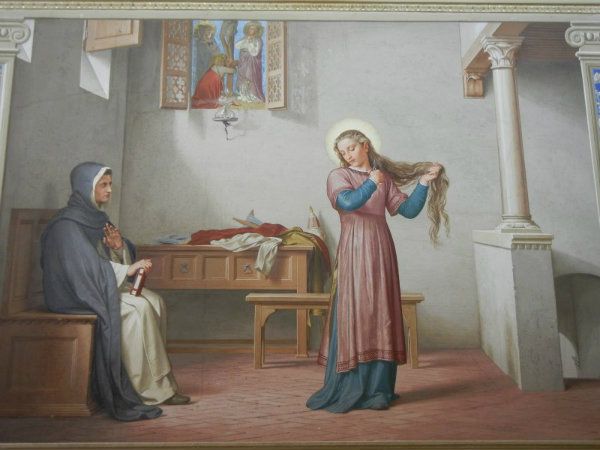
From what I've gathered, I believe it's painted on a wall of her home in Siena. (Please correct me if I am mistaken). The painting depicts St. Catherine of Siena cutting off her hair in front of her mother when she was twelve years old. Her parents were insistent on finding her a husband, but St. Catherine cut off her beautiful hair as a way of declaring that she desired to belong to Christ alone. I found this subject compelling as I perceived that it would be a way to convey something powerful about my model, Dubh. Dubh just entered a monastery of Poor Clares on August 22nd. She has told me that what drew her to the cloister was the element of the total sacrifice to Christ. When my family came down to New York City to visit me, they spent a night here with the women missionaries. I was explaining to my mom, after she had met Dubh, what she was doing and what it meant. My mom asked me, genuinely confounded, "Why would she do that--be closed up away from the world?...she's so beautiful...". Remembering my mother's words reinforces the sense that this image of St. Catherine cutting her hair is particularly well suited for Dubh to model for. I feel that this image is iconic in a way, a way to encapsulate visually Dubh's sacrifice, of her beauty being "wasted" on Christ as the woman who anointed Jesus' feet "wasted" her perfume of great cost on Christ. Jesus is worth giving everything for, that's what this piece is about. Another way this subject matter connects with Dubh is that part of the ceremony of investiture of the Poor Clares, where they recieve their religious habit, is the cutting off of their hair, after St. Clare. Also, Dubh is named after St. Catherine of Siena-- "Dubh", which she goes by, is actually her second middle name...her first middle name is "Kathleen" (her first name is a variation of "Mary", as are all her sisters' first names).
Below are my drawing studies for the painting. These studies are drawn from life, the only element of the image which I will work with photographic references to develop is the skirt which will completely cover the figure, like in the reference paintings.
Initial drawing:
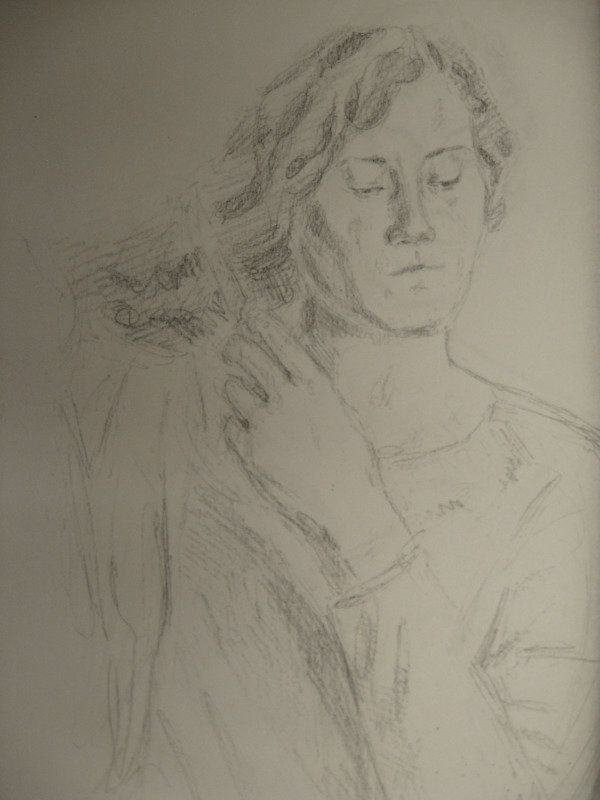
Hand study:

Drawings with the hand incorporated. I will go with the first one for the angle of her hand, the second one has more information in the face, particularly the nose:
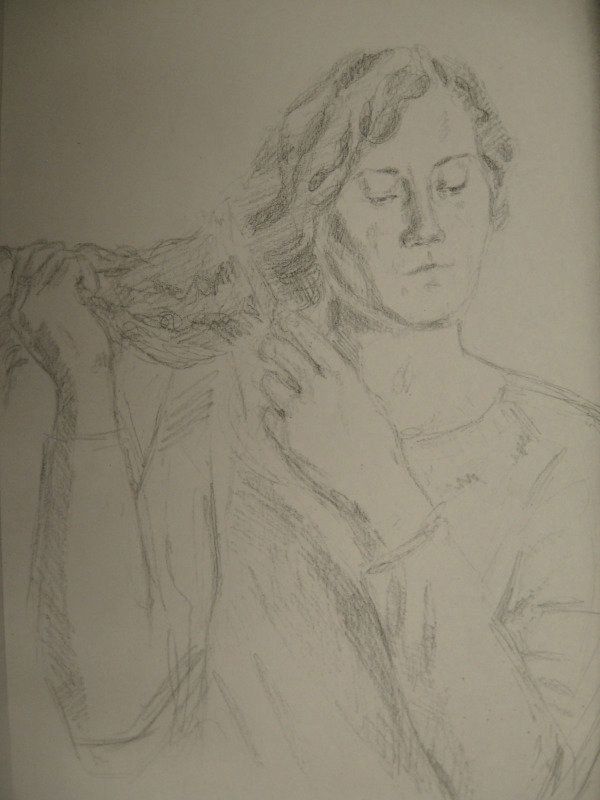
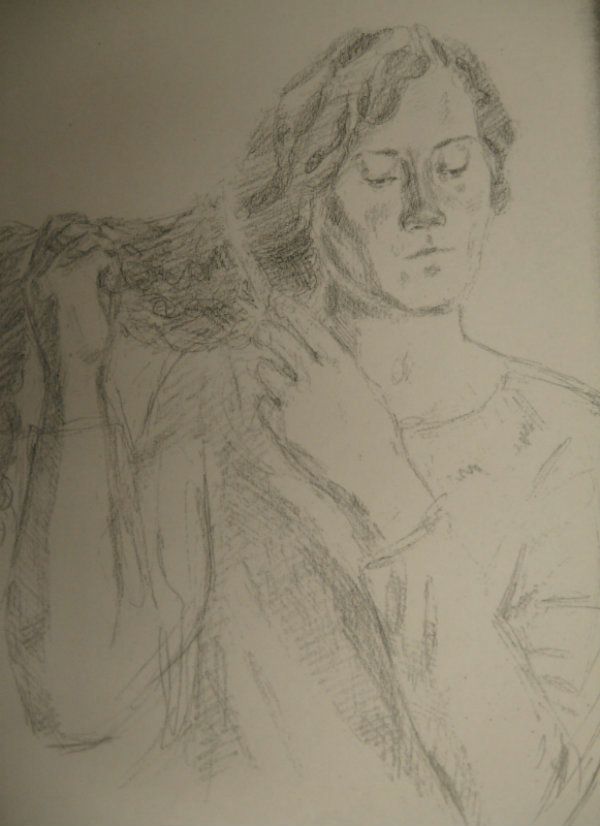
Rough full body sketch (with some of the bottom cut off in this photo):
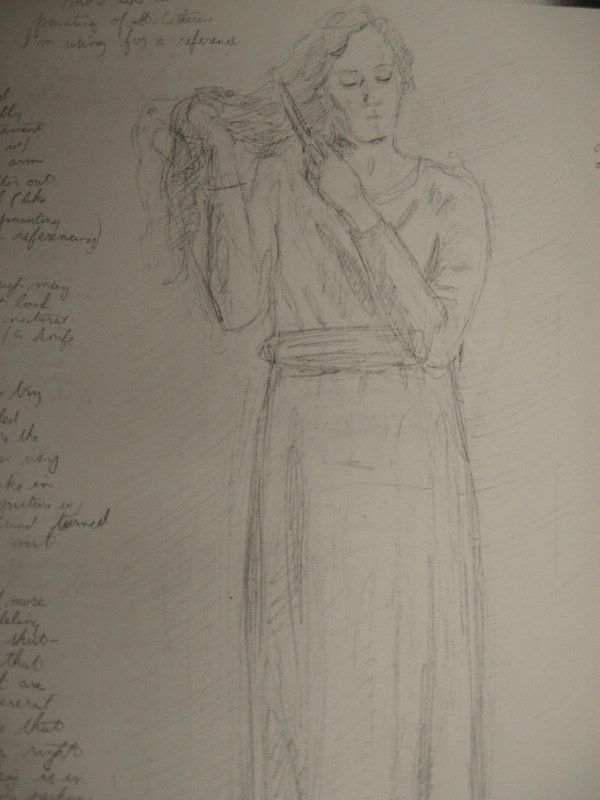
Please pray for Dubh as she begins this new chapter of her life as a Poor Clare. St. Catherine of Siena-- pray for us!
Sunday, September 2, 2012
Progress on Baby Study
Today I worked on my painting study for the Christ Child for my Madonna and Child project. Here's what I have now:
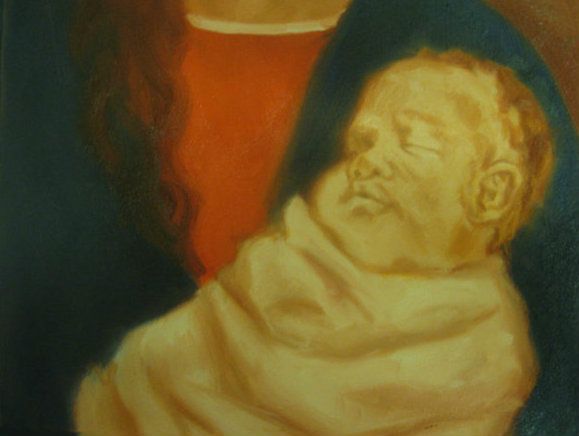
I'm focusing in this study on painting the child's face, though I did apply a layer of paint to the whole surface of the paper. Once I let this dry, I want to experiment with applying another layer of paint over the child-- that is why I left the image of him nearly monochromatic and haven't fully developed the range of values. When I've painted, I have had a tendency not to paint in layers so much, but it's something I'd like to explore further.
If the blanket the child is wrapped in looks a little awkward it's because I made it up more or less without a reference from life or a mannequin. In the final painting the Virgin Mary's hand will be covering much of the Christ Child's body so I'm hoping that this factor along with me tweaking the image until it seems natural and well integrated will eliminate or at the very least reduce to a minimum any awkwardness in this area.
Again, the purpose of this study is to practice painting off of a reference drawing. (As usually when I've painted people in college, it was directly from a live model before me). It takes a lot less time and is much less involved to draw someone from life than to paint them from life (particularly if you are not in your studio and just have your traveling sketchbook). To be able to make paintings based off of reference drawings really opens up a lot of possibilities and provides flexibility for me.

I'm focusing in this study on painting the child's face, though I did apply a layer of paint to the whole surface of the paper. Once I let this dry, I want to experiment with applying another layer of paint over the child-- that is why I left the image of him nearly monochromatic and haven't fully developed the range of values. When I've painted, I have had a tendency not to paint in layers so much, but it's something I'd like to explore further.
If the blanket the child is wrapped in looks a little awkward it's because I made it up more or less without a reference from life or a mannequin. In the final painting the Virgin Mary's hand will be covering much of the Christ Child's body so I'm hoping that this factor along with me tweaking the image until it seems natural and well integrated will eliminate or at the very least reduce to a minimum any awkwardness in this area.
Again, the purpose of this study is to practice painting off of a reference drawing. (As usually when I've painted people in college, it was directly from a live model before me). It takes a lot less time and is much less involved to draw someone from life than to paint them from life (particularly if you are not in your studio and just have your traveling sketchbook). To be able to make paintings based off of reference drawings really opens up a lot of possibilities and provides flexibility for me.
Wednesday, August 15, 2012
Beginnings of St. Lucy Project
This past June I had the privilege of attending my friend, Emily's, reception of the Rite of Consecration to a Life of Virginity. I had been in contact with Emily for approximately a year before being able to finally meet her in person in June to celebrate her consecration-- I was blessed to be able to stay with her for about a week.
The better part of a year ago, probably during one of our early phone conversations, one of us threw out the idea of me painting a picture of St. Lucy with Emily as my model. Sounded like an exciting project, but seeing as how we live on opposite sides of the country it didn't seem like so much of a sure thing that it would actually be realized. But when it worked out that I'd be flying down for her consecration, I made it a point for us to arrange a few modeling sessions, where I could draw her and take some reference photos.
In the months leading up to my visit with Emily, I was coming to discover my appreciation for Spanish Baroque painters, really connecting with their style. One series of paintings I got really excited about and inspired me a lot was Zurbaran's series of female saints. Here's an image of one of these fantastic paintings from the series posted below. There's a good selection of paintings from this series on this blog post. I saw that doing such a St. Lucy project influenced by Zurbaran's female saint paintings was an opportunity for me to put myself in dialouge with a great Catholic artist. I recognized this as a step towards inserting myself into the tradition of Catholic art.
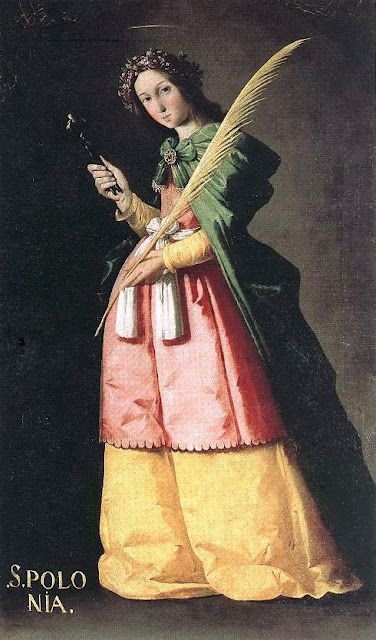
"Saint Apollonia" 1636 oil-on-canvas painted by Francisco de Zurbarán
So even before I had Emily model for me, I had a fairly good idea about the general way in which I wanted her posed, as I sought for this project to be in response to Zurbaran's women saint paintings. In other words, I posed Emily in a way that I felt was "Zurbaranesque", echoing his female saint paintings...her body facing one side, holding attributes of St. Lucy. Once I posed her during our first modeling session, I made this first drawing:

She is holding in her one hand a palm frond, the standard symbol of martrydom in Catholic art...Emily just happened to have the perfect one lying around in her room. In her other hand, which you cannot see in the above drawing, she is holding a plate on which I will depict a pair of eyes...St. Lucy's unique attribute. (If you are unfamiliar with Catholic art, saints are often depicted with objects called "attributes" which have some association with them in their lives and are used to indicate who they are). Like I mentioned above, a palm frond is an attribute or symbol of a martyr. It is a convention that martyrs, like St. Lucy, have as an attribute an object associated with their torture and death. Legend has it that part of St. Lucy's torture was having her eyes gouged out, with God later restoring her eyes, St. Lucy for this reason is the patron saint for the blind, with her name also meaning "light". For more on St. Lucy, refer to this article.
In a later session (one which nearly had me miss my flight home as I was so into it and was pushing it for time)...I did another drawing for this project focusing on her face. I wanted to make sure I had enough information for the face in my completed painting. I was struck by the power of Emily's gaze and the intensity and beauty of her eyes...I wanted to make sure I captured this element as best as I could as I recognized that it would give this piece power. As I was posing her initially, I didn't come in knowing that I wanted the subject to make eye contact with the viewer, but once I had her make eye contact I knew that it was right. Not only is it consistent with many of Zurbaran's female saints which make direct eye contact with the viewer, but I felt that for a depiction of St. Lucy that it was particularly appropriate and striking. This is because of the aforementioned legend involving Lucy and her eyes, her being the patron saint of the blind, and her name meaning "light" (with light of course being linked with vision). Here are a couple photocopies of this drawing of Emily's face from which I made some slightly varying versions for the sake of expirimentation:
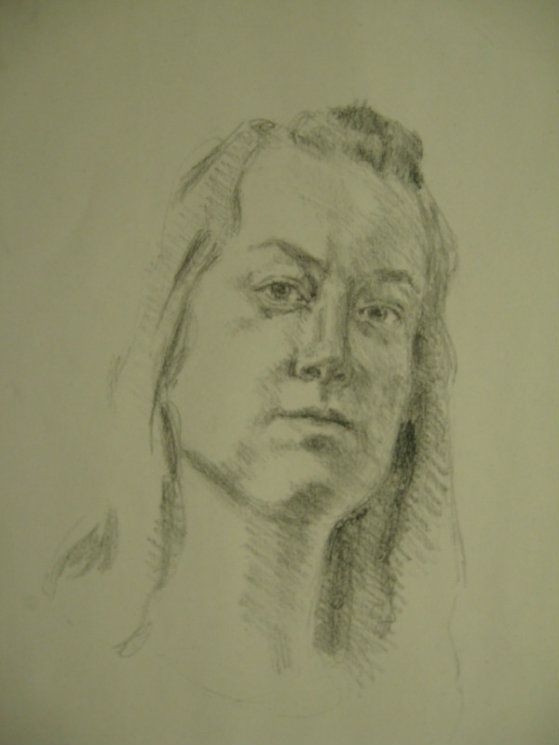
In this above version I played around by adding some shading.

In this one I emphasized the eyes a bit.
As a last image for this post I'll share a reference photo I was able to take the day of her consecration, while she was in her wedding dress. From this reference photo I will develop the figure's dress in the painting:
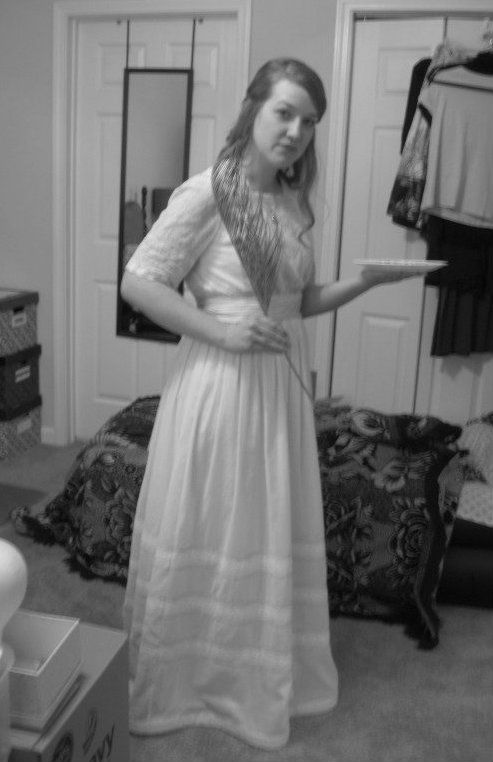
I've been changing my reference photographs to black and white not just to conserve on color ink in printing, but also so that my painting will not end up looking like a photograph. In putting the image in black and white and then doing drawing studies from it, I hope to distance myself or abstract from the photo (while still of course preserving a likeness to the actual dress). I want to do this so that the information I draw from my photographic references are processed or modified through drawing so that it integrates in naturally with my drawn references...which I want to guide the project stylistically in a more dominant way than my photographs. Her dress is just perfect for me to work with in my painting, it has the qualities which I want in the figure's dress...it is simple and neutral and timeless enough to be suitible for a representation of St. Lucy, yet at the same time it has a particularity which draws out the individuality of my model.
This project is particularly exciting for me because I feel that my model has a real connection with the saint she is portraying. Emily expressed an interest in modeling as St. Lucy, so I'd say it's safe to assume that she has some sort of personal devotion or affinity towards the saint. But beyond this, St. Lucy recieved the same Rite of Consecration to a Life of Virginity that Emily has now recieved. She modeled for this project the immediate days surrounding her consecration (and the day of her consecration) which gives this piece a certain power or gravity. Also, legend has it that St. Lucy was very beautiful...Emily is likewise connected with Lucy in this regard-- I may be a little biased because she is my friend, and I haven't really been to a lot of weddings, but she's the most beautiful bride I have seen yet. This painting will have a richness with layers of meaning. One thing that I hope to do through sacred art is to make the mysteries of the faith, including the saints, contemporary-- yet at the same time preserving a sense of timelessness. In other words, the faith is ever ancient yet ever new. St. Lucy is a saint of antiquity--yet she is relevent to us today. It was an honor for Emily to model for me for this project as she was the one that God placed in my path to help me to make present to our time and place St. Lucy, with whom she shares the title of "Bride of Christ".
I have made some more progress on the project than I have shared here in this post...but I feel this a natural breaking point--I will share more soon.
If you're interested Emily has a blog about vocations and discernment you could check out. (She writes under a pen name).
St. Lucy-- pray for us!
The better part of a year ago, probably during one of our early phone conversations, one of us threw out the idea of me painting a picture of St. Lucy with Emily as my model. Sounded like an exciting project, but seeing as how we live on opposite sides of the country it didn't seem like so much of a sure thing that it would actually be realized. But when it worked out that I'd be flying down for her consecration, I made it a point for us to arrange a few modeling sessions, where I could draw her and take some reference photos.
In the months leading up to my visit with Emily, I was coming to discover my appreciation for Spanish Baroque painters, really connecting with their style. One series of paintings I got really excited about and inspired me a lot was Zurbaran's series of female saints. Here's an image of one of these fantastic paintings from the series posted below. There's a good selection of paintings from this series on this blog post. I saw that doing such a St. Lucy project influenced by Zurbaran's female saint paintings was an opportunity for me to put myself in dialouge with a great Catholic artist. I recognized this as a step towards inserting myself into the tradition of Catholic art.

"Saint Apollonia" 1636 oil-on-canvas painted by Francisco de Zurbarán
So even before I had Emily model for me, I had a fairly good idea about the general way in which I wanted her posed, as I sought for this project to be in response to Zurbaran's women saint paintings. In other words, I posed Emily in a way that I felt was "Zurbaranesque", echoing his female saint paintings...her body facing one side, holding attributes of St. Lucy. Once I posed her during our first modeling session, I made this first drawing:

She is holding in her one hand a palm frond, the standard symbol of martrydom in Catholic art...Emily just happened to have the perfect one lying around in her room. In her other hand, which you cannot see in the above drawing, she is holding a plate on which I will depict a pair of eyes...St. Lucy's unique attribute. (If you are unfamiliar with Catholic art, saints are often depicted with objects called "attributes" which have some association with them in their lives and are used to indicate who they are). Like I mentioned above, a palm frond is an attribute or symbol of a martyr. It is a convention that martyrs, like St. Lucy, have as an attribute an object associated with their torture and death. Legend has it that part of St. Lucy's torture was having her eyes gouged out, with God later restoring her eyes, St. Lucy for this reason is the patron saint for the blind, with her name also meaning "light". For more on St. Lucy, refer to this article.
In a later session (one which nearly had me miss my flight home as I was so into it and was pushing it for time)...I did another drawing for this project focusing on her face. I wanted to make sure I had enough information for the face in my completed painting. I was struck by the power of Emily's gaze and the intensity and beauty of her eyes...I wanted to make sure I captured this element as best as I could as I recognized that it would give this piece power. As I was posing her initially, I didn't come in knowing that I wanted the subject to make eye contact with the viewer, but once I had her make eye contact I knew that it was right. Not only is it consistent with many of Zurbaran's female saints which make direct eye contact with the viewer, but I felt that for a depiction of St. Lucy that it was particularly appropriate and striking. This is because of the aforementioned legend involving Lucy and her eyes, her being the patron saint of the blind, and her name meaning "light" (with light of course being linked with vision). Here are a couple photocopies of this drawing of Emily's face from which I made some slightly varying versions for the sake of expirimentation:

In this above version I played around by adding some shading.

In this one I emphasized the eyes a bit.
As a last image for this post I'll share a reference photo I was able to take the day of her consecration, while she was in her wedding dress. From this reference photo I will develop the figure's dress in the painting:

I've been changing my reference photographs to black and white not just to conserve on color ink in printing, but also so that my painting will not end up looking like a photograph. In putting the image in black and white and then doing drawing studies from it, I hope to distance myself or abstract from the photo (while still of course preserving a likeness to the actual dress). I want to do this so that the information I draw from my photographic references are processed or modified through drawing so that it integrates in naturally with my drawn references...which I want to guide the project stylistically in a more dominant way than my photographs. Her dress is just perfect for me to work with in my painting, it has the qualities which I want in the figure's dress...it is simple and neutral and timeless enough to be suitible for a representation of St. Lucy, yet at the same time it has a particularity which draws out the individuality of my model.
This project is particularly exciting for me because I feel that my model has a real connection with the saint she is portraying. Emily expressed an interest in modeling as St. Lucy, so I'd say it's safe to assume that she has some sort of personal devotion or affinity towards the saint. But beyond this, St. Lucy recieved the same Rite of Consecration to a Life of Virginity that Emily has now recieved. She modeled for this project the immediate days surrounding her consecration (and the day of her consecration) which gives this piece a certain power or gravity. Also, legend has it that St. Lucy was very beautiful...Emily is likewise connected with Lucy in this regard-- I may be a little biased because she is my friend, and I haven't really been to a lot of weddings, but she's the most beautiful bride I have seen yet. This painting will have a richness with layers of meaning. One thing that I hope to do through sacred art is to make the mysteries of the faith, including the saints, contemporary-- yet at the same time preserving a sense of timelessness. In other words, the faith is ever ancient yet ever new. St. Lucy is a saint of antiquity--yet she is relevent to us today. It was an honor for Emily to model for me for this project as she was the one that God placed in my path to help me to make present to our time and place St. Lucy, with whom she shares the title of "Bride of Christ".
I have made some more progress on the project than I have shared here in this post...but I feel this a natural breaking point--I will share more soon.
If you're interested Emily has a blog about vocations and discernment you could check out. (She writes under a pen name).
St. Lucy-- pray for us!
Sunday, August 12, 2012
A little bit of progress on Madonna and Child project.
Currently I have three projects underway depicting religious figures. There is this one of The Blessed Virgin Mary and the Christ Child which I posted on in my previous entry and then I have two other images I'm working on, each of a female saint. I will share about these last two projects soon. Here I just wanted to update my readers on what I've done with this Madonna and Child project since I've last posted.

First, after taking an artist's advice, I softened the expression of the Marian figure in my drawing reference/ photocopy of the original drawing with its subsequent modifications. It's just a few very slight changes I made to give her a slight smile, but I feel it is a big improvement and does serve to make her more approachable.
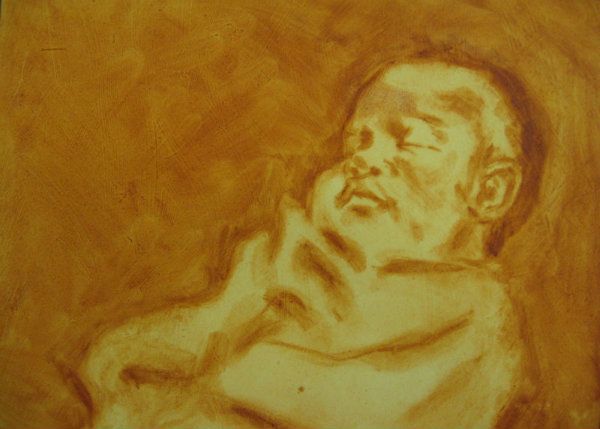
Next, I made another minor modifaction to my paint study of the Christ Child, where the same artist who advised me to soften the Virgin Mary's expression observed that the forehead of this baby image was elongated, making him look too adult-- so I fixed that as well.

Another way I've progressed with this project is that I started to seek out a better idea of what my color scheme for the finished painting will be. I made this study by painting directly over one of my photocopies of the drawn image. I made some paint swatches as well of variations of red and blue, but this is the only developed color study I've done in the sense of seeing how the different colors of the image relate to each other. I may do some other color studies before I actually do the final painting. One thing I remember about making this color study is tweaking it so that the white in the image seemed more balanced. Initially, the skin tone was darker and the white of the blanket that the Christ Child is wrapped in was lighter. It bothered me how the white of the blanket popped out without tying into another light color of similar weight, as the color scheme is pretty dark. I sought to address this by bringing the value of the skin tone and the value of the blanket closer together--by lightening the skin and darkening the blanket. Also, another way I sought out some balance of the light fabric in the paint study was by incorporating white into the clothing of the Blessed Virgin Mary. Through my study of different paintings of the Virgin Mary, I noticed that it was a convention in many images of her for there to be a layer of white fabric closest to her body, peeking out from under the layer over it...I'm assuming to symbolize her purity. So I adopted this in my paint study. Speaking of conventions in regard to the clothing of the Blessed Virgin Mary in art...I have been told by an art historian the reason as to why she if often depicted with red clothing covered with blue. The red I was told is meant to symbolize her humanity and the blue is mean to symbolize heaven, purity, or divinity. I am fascinated how even her clothing can drive home the theme of the incarnation...of heaven and earth meeting within her, and her giving God in the flesh to the world.

First, after taking an artist's advice, I softened the expression of the Marian figure in my drawing reference/ photocopy of the original drawing with its subsequent modifications. It's just a few very slight changes I made to give her a slight smile, but I feel it is a big improvement and does serve to make her more approachable.

Next, I made another minor modifaction to my paint study of the Christ Child, where the same artist who advised me to soften the Virgin Mary's expression observed that the forehead of this baby image was elongated, making him look too adult-- so I fixed that as well.

Another way I've progressed with this project is that I started to seek out a better idea of what my color scheme for the finished painting will be. I made this study by painting directly over one of my photocopies of the drawn image. I made some paint swatches as well of variations of red and blue, but this is the only developed color study I've done in the sense of seeing how the different colors of the image relate to each other. I may do some other color studies before I actually do the final painting. One thing I remember about making this color study is tweaking it so that the white in the image seemed more balanced. Initially, the skin tone was darker and the white of the blanket that the Christ Child is wrapped in was lighter. It bothered me how the white of the blanket popped out without tying into another light color of similar weight, as the color scheme is pretty dark. I sought to address this by bringing the value of the skin tone and the value of the blanket closer together--by lightening the skin and darkening the blanket. Also, another way I sought out some balance of the light fabric in the paint study was by incorporating white into the clothing of the Blessed Virgin Mary. Through my study of different paintings of the Virgin Mary, I noticed that it was a convention in many images of her for there to be a layer of white fabric closest to her body, peeking out from under the layer over it...I'm assuming to symbolize her purity. So I adopted this in my paint study. Speaking of conventions in regard to the clothing of the Blessed Virgin Mary in art...I have been told by an art historian the reason as to why she if often depicted with red clothing covered with blue. The red I was told is meant to symbolize her humanity and the blue is mean to symbolize heaven, purity, or divinity. I am fascinated how even her clothing can drive home the theme of the incarnation...of heaven and earth meeting within her, and her giving God in the flesh to the world.
Sunday, July 1, 2012
Madonna and Child project underway
Here I have to share with you the beginnings of a project I have underway. This is my first venture into the subject of Madonna and Child. One of my ministries with LAMP is to go to a Good Counsel Home, a shelter for homeless pregnant women and their children. During my time spent there I have had some opportunities to draw the babies in the nursery. I figured that I could try to use some of these drawings of babies as references for the Christ Child as I develop a finished painting of the Blessed Virgin Mary and the infant Jesus. I was drawn to one drawing of a baby to work with as I saw how I could integrate the image in with a figure depicting Mary. To do this I made a make-shift mannequin out of blankets and had one of my housemates and fellow missionaries, Lynn, modeling as the Blessed Virgin Mary, hold the bundle oriented in such a way that matched up with the orientation of the baby in the drawing and drew her.
Then I took my drawing and photocopied it, from there with charcoal I drew in the image of the baby over top of the copy- bringing the two figures together. I sought to bring them together in a way that was natural and organic. I also used my artistic license to lengthen the hair on the figure of Mary. So at this point I had a drawing to work off of to make a painting.
My next step in forwarding this project, which I did today, was to practice painting off of one of my drawings as a reference- a technique I haven't really worked with before. I started making a paint study based off the image of the baby I'm working with in this project. Today I just made the first layer in burnt sienna. Next time I work on this I'll work over this first layer to build up a painted image.
As I delve into making sacred art, or art with explicitly religious imagery, I am seeking to integrate in my love of drawing people from life and capturing a likeness to my model. Also, I'm trying to educate myself in what would be a good balance between creating an image accurate to the model and subtle abstraction/ idealization of the image I'm developing. One theme I feel drawn to as I begin to make sacred art, a theme which has carried over from my previous work, is having different layers of meaning in my works of art. What I mean by this in this piece would be that this is an image of Lynn, my model, and the baby I drew and it is also an image of the Blessed Virgin Mary and the Christ Child- and these two dimensions interpenetrate and inform each other. I see every woman as having an inherent link to Mary the "New Eve" and true model of authentic womanhood. As Mary, by her feminine gift, opened herself to receive within herself and bear forth divine life- in the flesh, all women have a call to receive and bring forth life- whether that life be physical or spiritual. The subject of Madonna and Child is an exploration of the mystery of motherhood. Lynn, my model in this piece, comes with me to Good Counsel and has a role of being -if not a physical mother- a spiritual mother to these children in her time spent with them and through her prayers. So she is particularly well suited for this subject. In this way is this painting an image of Lynn and the Good Counsel baby while at the same time being an image of Mary and the infant Jesus.
Then I took my drawing and photocopied it, from there with charcoal I drew in the image of the baby over top of the copy- bringing the two figures together. I sought to bring them together in a way that was natural and organic. I also used my artistic license to lengthen the hair on the figure of Mary. So at this point I had a drawing to work off of to make a painting.
My next step in forwarding this project, which I did today, was to practice painting off of one of my drawings as a reference- a technique I haven't really worked with before. I started making a paint study based off the image of the baby I'm working with in this project. Today I just made the first layer in burnt sienna. Next time I work on this I'll work over this first layer to build up a painted image.
As I delve into making sacred art, or art with explicitly religious imagery, I am seeking to integrate in my love of drawing people from life and capturing a likeness to my model. Also, I'm trying to educate myself in what would be a good balance between creating an image accurate to the model and subtle abstraction/ idealization of the image I'm developing. One theme I feel drawn to as I begin to make sacred art, a theme which has carried over from my previous work, is having different layers of meaning in my works of art. What I mean by this in this piece would be that this is an image of Lynn, my model, and the baby I drew and it is also an image of the Blessed Virgin Mary and the Christ Child- and these two dimensions interpenetrate and inform each other. I see every woman as having an inherent link to Mary the "New Eve" and true model of authentic womanhood. As Mary, by her feminine gift, opened herself to receive within herself and bear forth divine life- in the flesh, all women have a call to receive and bring forth life- whether that life be physical or spiritual. The subject of Madonna and Child is an exploration of the mystery of motherhood. Lynn, my model in this piece, comes with me to Good Counsel and has a role of being -if not a physical mother- a spiritual mother to these children in her time spent with them and through her prayers. So she is particularly well suited for this subject. In this way is this painting an image of Lynn and the Good Counsel baby while at the same time being an image of Mary and the infant Jesus.
Monday, May 28, 2012
A few recent drawings.
Here are a few recent drawings of mine. I have others I'd like to put on but at least this is something seeing how I haven't posted anything in months and months. I apologize for the poor image quality...but at least now I've found that I have access to a scanner, if only for a pretty small window of time once a week--so hopefully I'll be able to get the blog back up and running a bit.
I've been wanting to experiment with producing art with more explicitly religious themes (which I guess you would call sacred art). I think the most natural way for me to delve into this would to work on making some Madonna and Child images. As a missionary, one place I visit during the week is a Good Counsel home, which is a home for homeless pregnant women and their young children. I've taken my time spent with the babies in the nursery there as an opportunity to draw them and become more familiar with their forms. Before visiting the Good Counsel home, I had not had such an environment where I'm regularly exposed to babies that I am able to draw. So, in my drawing these children, I have been able to accumulate some potential sources to work from in depicting the Christ child. Also, it helps that I am currently living with three other missionaries who are willing to model for me, posing as Our Lady.
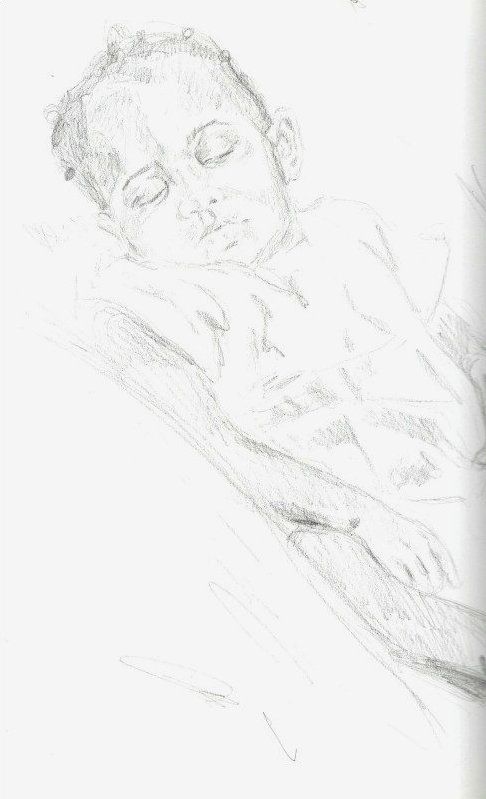
Perhaps the next thing I could scan in and get up on the blog is my first stab at integrating the image of a child taken from the drawings I have done at Good Counsel with one of my housemates modeling for me as the Blessed Virgin. I'll plan on writing about my process more when I have the actual relevant images up...but I feel I was able to get a natural and organic looking image from which I could potentially develop some studies and more finished paintings of the Madonna and Child. The image below I also see as potentially being something I could work off of, if I were to develop it by having Lynn, my housemate, who is depicted here model for me, replicating this pose. What is nice about this image is that it shows how the two figures connect, meaning that I could develop natural and convincing works-- where the figure of the mother and of the child are well integrated-- that are more finished based off of it.
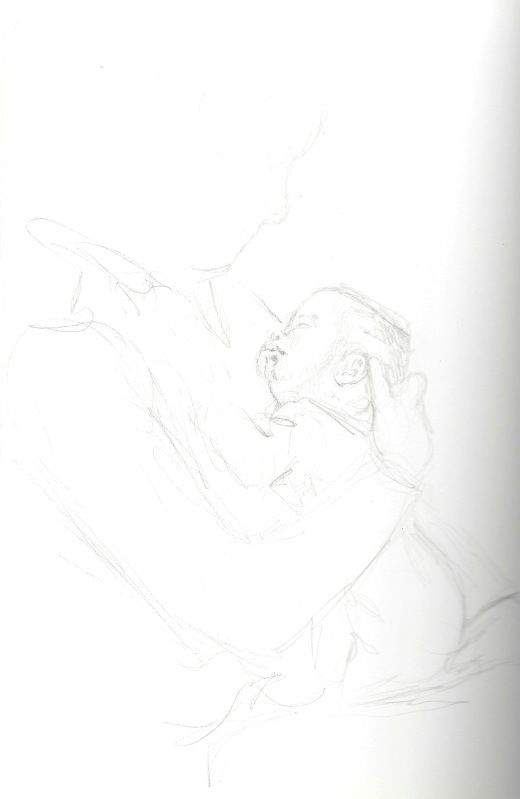
We female missionaries have recently moved to a new place in the Bronx. In our new building there has a room in the basement where I have been able to set up an art studio. As of this past week it is ready to go, so I can start painting at any time. My first projects will be making studies where I experiment with making paintings from drawings. I haven't really done this, making paintings from my drawings, but it would definitely open up a lot of doors for me artistically-- making sacred art would be actually accessible to me through such a process, because I could work from and bring together images of people that I have drawn. This is handy because it takes a lot less time and is more accessible to make a drawing of a person than to paint them. At this point in time I wouldn't be able to feasibly paint a baby from life for instance (I can't just rent out a baby to take to my studio to paint!), but drawing them is something I am able to do. A Catholic painter I have met since being in New York, Ken Woo, encouraged me to explore making paintings using my drawings. When you think of it, this is an old technique used by artists. Renaissance painters focused a lot on developing a drawing before starting to paint from it. I have more I'd like to write about this. Perhaps once I actually start giving it a go I'll post on the topic.

Perhaps the next thing I could scan in and get up on the blog is my first stab at integrating the image of a child taken from the drawings I have done at Good Counsel with one of my housemates modeling for me as the Blessed Virgin. I'll plan on writing about my process more when I have the actual relevant images up...but I feel I was able to get a natural and organic looking image from which I could potentially develop some studies and more finished paintings of the Madonna and Child. The image below I also see as potentially being something I could work off of, if I were to develop it by having Lynn, my housemate, who is depicted here model for me, replicating this pose. What is nice about this image is that it shows how the two figures connect, meaning that I could develop natural and convincing works-- where the figure of the mother and of the child are well integrated-- that are more finished based off of it.

We female missionaries have recently moved to a new place in the Bronx. In our new building there has a room in the basement where I have been able to set up an art studio. As of this past week it is ready to go, so I can start painting at any time. My first projects will be making studies where I experiment with making paintings from drawings. I haven't really done this, making paintings from my drawings, but it would definitely open up a lot of doors for me artistically-- making sacred art would be actually accessible to me through such a process, because I could work from and bring together images of people that I have drawn. This is handy because it takes a lot less time and is more accessible to make a drawing of a person than to paint them. At this point in time I wouldn't be able to feasibly paint a baby from life for instance (I can't just rent out a baby to take to my studio to paint!), but drawing them is something I am able to do. A Catholic painter I have met since being in New York, Ken Woo, encouraged me to explore making paintings using my drawings. When you think of it, this is an old technique used by artists. Renaissance painters focused a lot on developing a drawing before starting to paint from it. I have more I'd like to write about this. Perhaps once I actually start giving it a go I'll post on the topic.
Subscribe to:
Posts (Atom)




